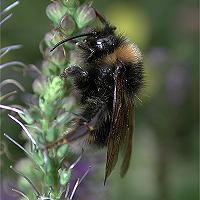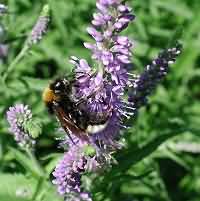Vestal Cuckoo Bumblebee Bombus vestalis
As stated before it may be very difficult at times to tell the various bumblebees apart. And the Cuckoo Bumblebees even add extra complications. These are bumblebees that do not make their own nest. The females seek entrance to another bumblebee's nest and simply deposit their eggs, leaving it to the host to bring up the larvae. Various species of cuckoo bumblebees are in existence and quite often they are the spitting image of their hosts! They are also known as parasitic bumblebees. The Vestal Cuckoo Bumblebee below is a parasite to the Earth Bumblebee, to which it bears a remarkable resemblance. Cuckoo bumblebees do not know workers or queens, just females, all capable of laying eggs and uncapable of doing any work. The females of the Vestal Cuckoo Bumblebee are about the same size as the queens of the Earth Bumblebee. Males usually are 15 to 17 mm long and may reach a wingspan of 35 mm. Because they never care about their off spring the females of all cuckoo bumblebees lack the special pollencollecting hairs on their legs. All non-parasitic bumblebees have these 'baskets' as these bushes of hairs are called and use them to transport pollen to the nest. So cuckoo bumblebees not only cheat on their relatives, they fool plants as well. Lacking the baskets they are not very contributive in the pollination proces. The Vestal Cuckoo Bumblebee is not very common in gardens, even though it may be seen in greater numbers in some years, while being absent in others.
The scientific name Psithyrus vestalis is commonly used for this species.
As stated before it may be very difficult at times to tell the various bumblebees apart. And the Cuckoo Bumblebees even add extra complications. These are bumblebees that do not make their own nest. The females seek entrance to another bumblebee's nest and simply deposit their eggs, leaving it to the host to bring up the larvae. Various species of cuckoo bumblebees are in existence and quite often they are the spitting image of their hosts! They are also known as parasitic bumblebees. The Vestal Cuckoo Bumblebee below is a parasite to the Earth Bumblebee, to which it bears a remarkable resemblance. Cuckoo bumblebees do not know workers or queens, just females, all capable of laying eggs and uncapable of doing any work. The females of the Vestal Cuckoo Bumblebee are about the same size as the queens of the Earth Bumblebee. Males usually are 15 to 17 mm long and may reach a wingspan of 35 mm. Because they never care about their off spring the females of all cuckoo bumblebees lack the special pollencollecting hairs on their legs. All non-parasitic bumblebees have these 'baskets' as these bushes of hairs are called and use them to transport pollen to the nest. So cuckoo bumblebees not only cheat on their relatives, they fool plants as well. Lacking the baskets they are not very contributive in the pollination proces. The Vestal Cuckoo Bumblebee is not very common in gardens, even though it may be seen in greater numbers in some years, while being absent in others.
The scientific name Psithyrus vestalis is commonly used for this species.





